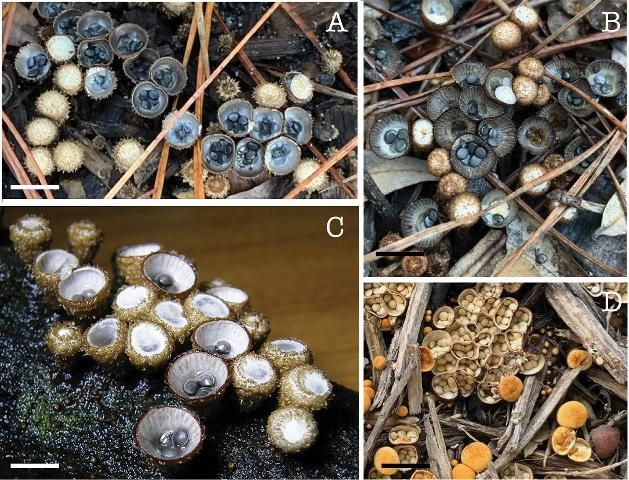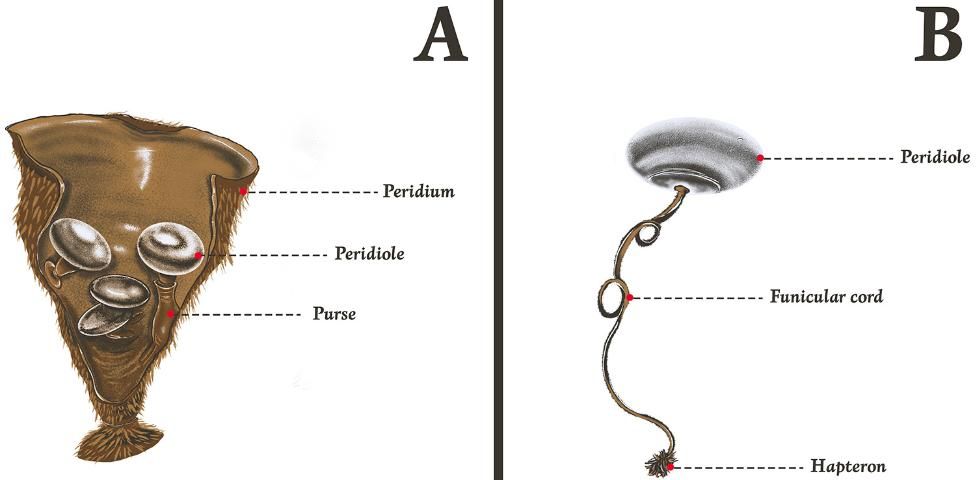Summary
The "bird's nest" fungi (Nidulariaceae) are charismatic mushrooms that look like small nests containing multiple tiny eggs. Because the ecological role of bird's nest fungi is to decompose wood, they are extremely common in disturbed areas with plant debris and mulch, such as trails and backyard gardens. These fungi tend to grow in large clusters, so it is common to see ten to a hundred of these "nests" at once. Bird's nest fungi are not considered dangerous to plants, animals, or humans.
Introduction
Despite the name, bird's nest fungi have little to do with birds or nests. In fact, these mushrooms got their common name because they resemble tiny bird's nests. You might have seen them in your backyard or come across them on local hiking trails. Bird's nest fungi are unique in both their appearance and their dispersal mechanism. If you take a closer look, you will notice several "eggs" inside each "nest" (Figure 1). These so-called eggs contain millions of fungal spores that will disperse by splashing and grow into a new fungal individual. Bird's nest fungi obtain nutrients by decomposing organic matter, mainly plant-based materials. Although they look quite different than other fungi, bird's nest fungi are related to the common fungi that we find in supermarkets, including button mushrooms, shitake mushrooms, and oyster mushrooms. They all belong to the same order of fungi, called Agaricales, which includes many species of gilled mushrooms.

Credit: A. Matthew E. Smith, UF/IFAS; B. Matthew E. Smith, UF/IFAS; C. Joan Knapp; D. Nattapol Kraisitudomsook.
Morphology
The bird's nest fungi belong to the family Nidulariaceae (Agaricales, Basidiomycota). They are found growing on soil, mulch, woody debris, logs, and sometimes animal dung (Brodie 1975). The nests (known as a peridium; Figure 2) are attached to the substrate via a network of fungal tissues called a mycelium. As the fungus matures, the egg-like spore mass (known as peridioles; Figure 2) forms within the nest. There can be as many as 30 million spores in a single peridiole (Hassett et al. 2015), so an individual bird's nest fungus fruiting body could have more than a billion spores! Peridioles are typically attached to the peridium via a thin string (known as a funicular cord; Figure 2) with a sticky end (known as a hapteron; Figure 2). Both the funicular cord and the hapteron are coiled and packed inside an envelope (known as a purse; Figure 2). Each peridiole has its own purse, which remains intact until dispersal occurs.

Credit: Randy Fernandez
Fruiting bodies of bird's nest fungi typically take 2 weeks to fully develop (Flegler 1979). There are two major stages of fruiting body development. In the first (immature) stage, peridia of some species are topped with a fuzzy and thin covering. These coverings are typically white for species in the genus Cyathus and yellow for species in the genus Crucibulum. As the fungus matures, the covering opens and exposes the peridioles to the outside world. The peridia of bird's nest fungi are usually some shade of white, yellow, or brown on the outside and slightly paler on the inside. Some peridia develop grooves on the inside surface or hairs on the outside surface. These peridium features vary depending on the species. Bird's nest fungi are also highly diverse in their shapes and sizes. They can range from 1 to 25 mm in height and 2 to 10 mm in width. They also appear in a variety of shapes such as cylindrical (cup-shaped), conical (inverted cone-shaped), and globose (ball-shaped). There are five genera of bird's nest fungi, but only Cyathus and Crucibulum have been found in the southeastern United States.
Cyathus is Greek for "cup," whereas Crucibulum is a Latin word for "melting pot," both of which refer to the general shape of these fungi (Brodie 1975). The differences between these genera lie in the color of the peridioles. The peridia and peridioles of Crucibulum are light colors such as white, yellow, or light buff, whereas those of Cyathus are typically dark brown or black. Cyathus species are far more common in Florida than species in the genus Crucibulum.
Ecology and Phenology
Like many of their relatives, bird's nest fungi grow on decomposing substrates such as mulch, wood chips, leaf litter, fallen logs, and sometimes on animal dung. Bird's nest fungi are decomposers that absorb nutrients from dead organic materials and are sometimes referred to as "saprotrophic" (Wicklow et al. 1984). Thus, they play an important role in recycling nutrients and decomposing plant debris in Florida's backyards and natural ecosystems. Bird's nest fungi need rain for their reproduction and dispersal. Raindrops trigger the dispersal of peridioles by splashing them upward from the peridia, during which the purse is ruptured and the funicular cord is uncoiled and stretched out. After this, the funicular cord will sometimes wrap around a twig or branch and will stick to the plant material with the aid of the hapteron. The peridiole is now attached to the new substrate. This splashing mechanism of peridioles was beautifully demonstrated by Hassett et al. (2015) in their slow-motion video. It is unclear what happens to those peridioles following the splashing event or how they germinate. Further studies are warranted to examine the biology and germination of bird's nest fungi.
Bird's nest fungi have an extremely wide distribution and are found on all continents except Antarctica (White 1902). The most common species in the United States include Cyathus striatus, Cyathus olla, Cyathus stercoreus, Crucibulum laeve, and Crucibulum parvulum (Brodie 1975) (Fig. 1). In addition, the southeastern United States is home to at least three additional species: Cyathus annulatus, Cyathus pallidus, and Cyathus poepigii (Brodie 1970, 1950) (Fig. 1). Bird's nest fungi tend to grow and fruit year-round, but they are especially prolific during late summer and early fall (July–October) due to the abundant rainfall during this time of year. There are probably several other species in Florida and along the Gulf Coast, but it is unclear which of those are native to the United States and which have been introduced from other places. More research is needed to identify all the local species and accurately determine their distributions.
Toxicology and Treatment
To date, there is no evidence to suggest that bird's nest fungi are pathogenic to plants or toxic to humans or other animals. Thus, there is no need to worry when you see them in your garden. On the contrary, bird's nest fungi could be beneficial because they decompose unwanted organic matter in your backyard. The edibility of these fungi is still not clear. They seem too tough to be edible even when cooked. There are reports of Cyathus limbatus and Cyathus microsporus specimens being infused in water and consumed as a beverage by Native Americans (Brodie 1975). Nevertheless, these reports were anecdotal, and the physiological effect on humans has never been studied. We do not recommend that humans consume bird's nest fungi. Instead, we recommend that you enjoy their natural beauty and watch them flourish. However, if your child or pet accidentally consumes bird's nest fungi, monitor them closely and watch out for any unusual symptoms. When in doubt about any ingested mushrooms in Florida, please contact Florida Poison Control (800-222-1222) or Dr. Matthew E. Smith (trufflesmith@ufl.edu, 352-273-2837).
Bird's nest fungi can, however, become a nuisance when the peridioles are splashed out of the peridium and land on the exterior walls of your house or other structures. Because these peridioles are quite adhesive and can be difficult to remove, we suggest that mulch be kept at least one foot away from the edge of the house. Eradication of bird's nest fungi is impractical because of their extensive mycelium growth and abundant peridioles. It is possible to disturb the fungus by raking or plowing the mulched soil. Other fungi will then colonize the wood, which will eventually lead to a reduction in the number of bird's nest fungi. It also may be possible to reduce the splashing of peridioles by minimizing the use of sprinklers near bird's nest fungi. While fungicide may help decrease the population of bird's nest fungi, it is not recommended, because fungicides do not penetrate wood well and might cause unnecessary harm to the environment.
References
Brodie, H. J. 1950. "Notes on Two Little Known Bird's Nest Fungi from Southern United States." Mycologia 42:186–190.
Brodie, H. J. 1970. "A Previously Unnamed Species of Cyathus from the Cypress Hills, Alberta." Can. J. Bot. 48 (4): 749–750. https://doi.org/10.1139/b70-103
Brodie, H. J. 1975. The Bird's Nest Fungi. Toronto: University of Toronto Press.
Flegler, S. L. 1979. "An Improved Method for Production of Cyathus stercoreus Fruit Bodies in Culture." Mycologia 71:625–627.
Hassett, M. O., M. W. F. Fischer, N. P. Money, and N. Kennedy. 2015. "Short-Range Splash Discharge of Peridioles in Nidularia." Fungal Biol. 119:471–475. https://doi.org/10.1016/j.funbio.2015.01.003
White, V. S. 1902. "The Nidulariaceae of North America." Bull. Torrey Bot. Club 29:251–280.
Wicklow, D. T., R. Langie, S. Crabtree, and R. W. Detroy. 1984. "Degradation of Lignocellulose in Wheat Straw versus Hardwood by Cyathus and Related Species (Nidulariaceae)." Can. J. Microbiol. 30:632–636. https://doi.org/10.1139/m84-093